We are in the playoff stages for the 2022 World Cup in Qatar. Australia, which made history in the group stage and qualified Round of 16 against all odds for the second time, failed to resist the title candidate Argentina despite their good defensive performance. At Ahmad Bin Ali Stadium, Argentina defeated Australia 2-0, qualifying for the quarterfinal for the 10th time.
After a 2-1 shock loss against Saudi Arabia in their opener, La Albiceleste won their third consecutive victory in a tough game and avoided the knockout of the Round of 16 for the second time in a row after being kicked out by world cup holder France in 2018 tournament.
In this tactical analysis, we’re digging into the tactics of both teams through analytics and see the effectiveness of Australia’s compact block and its intensity during high pressure as well as how pressure triggers create big chances.
Lineups
Lionel Scaloni continued his narrow formation 4-3-3 with Emiliano Martinez in goal. Cristian Romero and Nicolas Otamendi as centre-backs. Nahuel Molina and Marcos Acuna were right and left fullbacks respectively. Enzo Fernández played a central midfielder, and Alexis Mac Allister and Rodrigo de Paul played on both sides, which gives the team fluidity in midfield. PSG star Lionel Messi was in front while Manchester City player Julián Álvarez and Alejandro Gomez were on both sides.
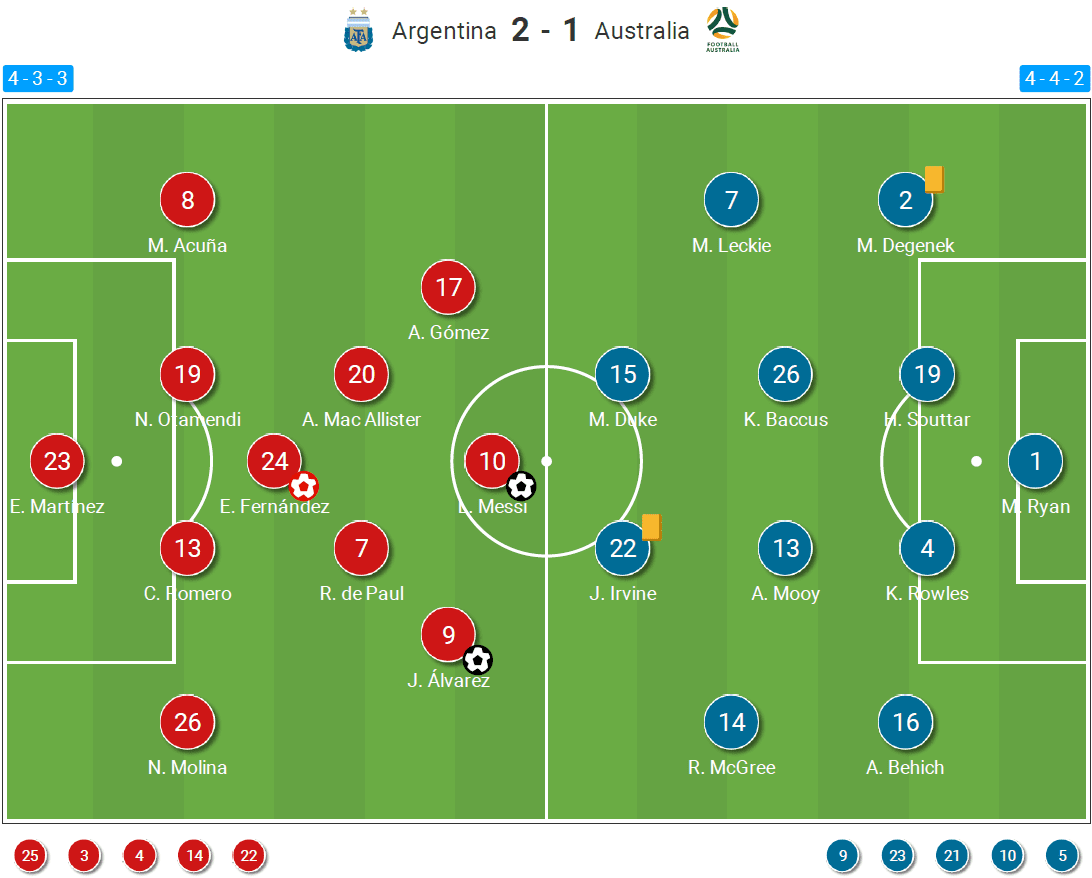
Graham Arnold systematized the Aussies in a 4-4-2 setup. Ex-Premier League Mathew Ryan was in goal. Harry Souttar and Kyle Rowles as centre-backs whilst Miloš Degenek and Aziz Behich were right and left fullbacks respectively. In midfield, the veteran Aaron Mooy with Jackson Irvine were central in the double pivot. In the wings, Matthew Leckie who scored the winning goal against Denmark was on the right and Keanu Baccus was on the left. Riley Mcree and Mitchell Duke are strikers.
Argentina failed to penetrate Australia’s compact defensive structure.
I can imagine Graham Arnold the coach of the Aussies decided after watching Argentina’s games against Saudi Arabia and Poland, to apply compact mid and low blocks against a team that has high-level players, especially Lionel Messi. and the impact of their existence between the lines.
In possession, The Argentinians diversified in 3-1-6 and 3-2-5 structures, which were highly interchangeable. Australia seemed to be in a 4-2-2 compact defensive structure to prevent them from creating any spaces in between lines.
In the Below figure, Enzo Fernández dropped between the center-backs to create 3 vs 2 in the first line to bypass Socceroos’ two strikers. While Lionel Messi dropped off to combine and create from deep, Rodrigo de Paul and Alexis Mac Allister exploited the half-spaces and the fullbacks pushed forward.

Earlier Argentina tried to take advantage of this numerical superiority and the left-side combination between Marcos Acuna, Alexis Mac Allister, and Alejandro Gomez through positional play and their dynamic movements to penetrate the block but they failed to sustain in this type because of the good movement of the block from side to side and well using of the side-line as an extra defender and created defensive numerical advantage on both sides.
Furthermore, While Australians’ fullbacks were busy with #8s, Argentina tried to progress above the mid-block by longballs for the overlapping fullbacks. But the execution was not sufficient to cause any danger.
Jackson Irvine and Matthew Leckie were too prominent, Here below after a good covering shadow of Argentina’s midfield then Enzo Fernández passed to Cristian Romero who faced immediately aggressive pressure that forced him to pass back while there are no pass options or room to carry the ball forward.
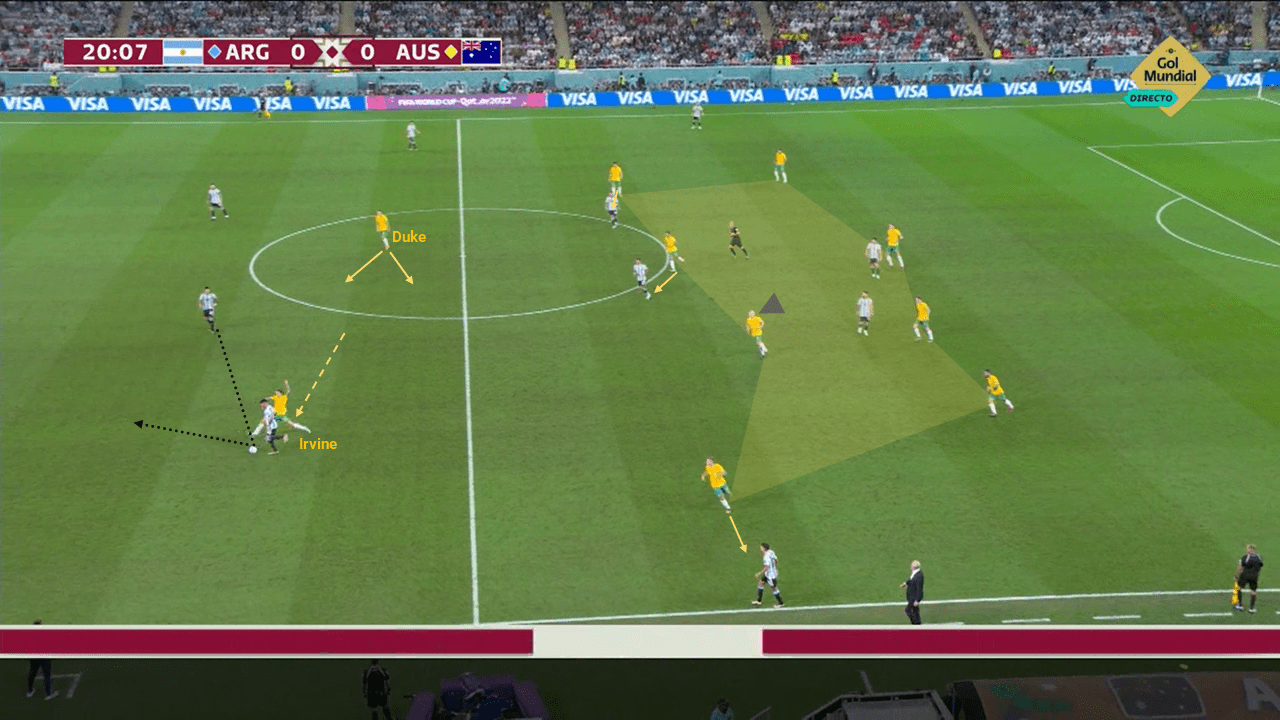
Lionel Scaloni reacted to this poor progression and changed Alejandro Gomez from left to right. He tried to create the combination that worked well against Poland. This combination depended on rotation between Lionel Messi and Rodrigo de Paul in the half-space to create superiority in between lines or create a space for underlapping FB or a dynamic striker to move into through off-ball movement. Also, for isolating RW on 1v1 on the flank.
Here in the below figure, Nahuel Molina overlapped. Kyle Rowles defender of Australia reacted well and stepped forward to mark Rodrigo de Paul which created the space but Riley McGree’s covering shadow and good pressing forced him to go back.
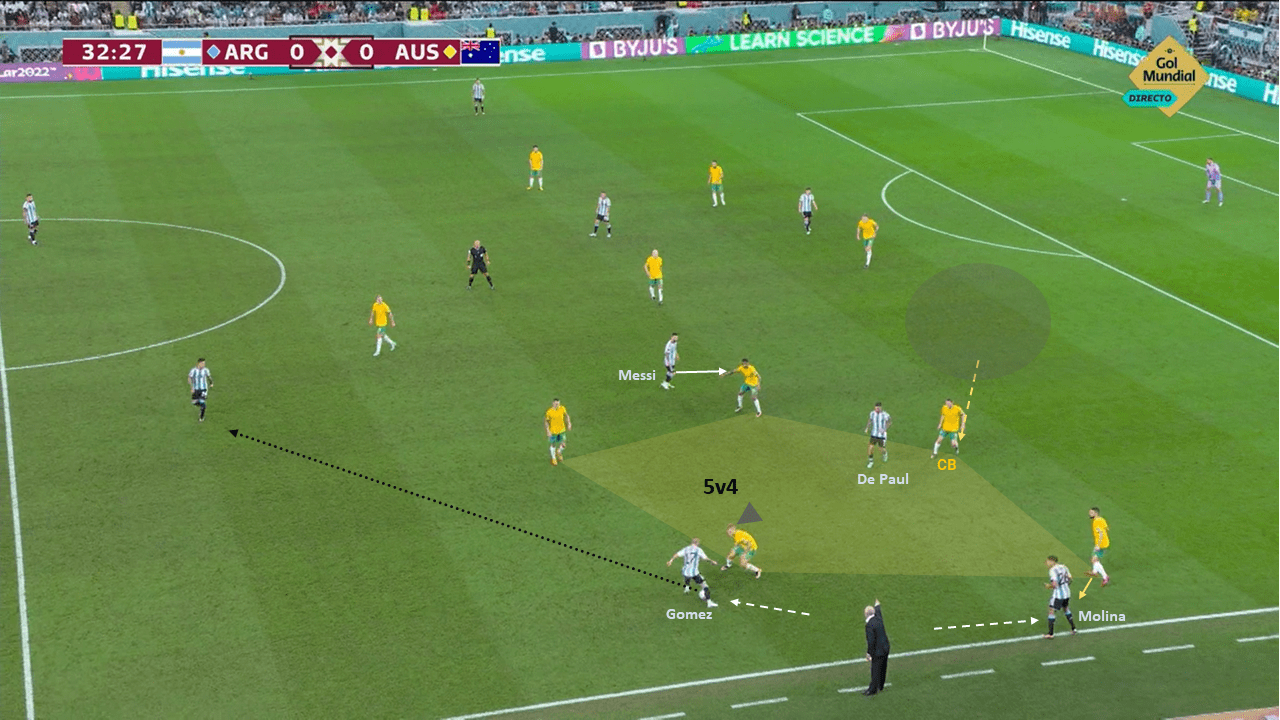
In the second half, Lisandro Martínez came on and Lionel Scaloni Quickly changed his setup to a pure 3-5-1-1 with a base 3-1. Here in the below figure, Enzo played a long ball to Marcos Acuna who dragged the opponent FB to press which created space behind him then Alexis Mac Allister moved to it. This idea didn’t create much danger.

Australia pressing high well
Australia didn’t just apply mid and low block well but they also applied a very tight high-pressing scheme which restricted Argentina to build up and create big chances.
Here in the below figure, In this case, the ball was with Nicolas Otamendi with limited options to pass. The Australian strikers marked and cover the shadow of Enzo Fernández. While their right winger closed the passing lane to Argentina FB and their FB, the right central midfielder reacted well to the dropping of Alexis Mac Allister and jumped to press him, his body shape making him a pressing trigger. And their LW moved back with the other CM to avoid any central superiority. Then they succeeded to gain it back.

Here below is another good high-pressing execution and well use of the touchline as an extra defender. Here The Socceroos had the numerical advantage through their scheme and limiting options for the ball carrier who then played a random long ball.
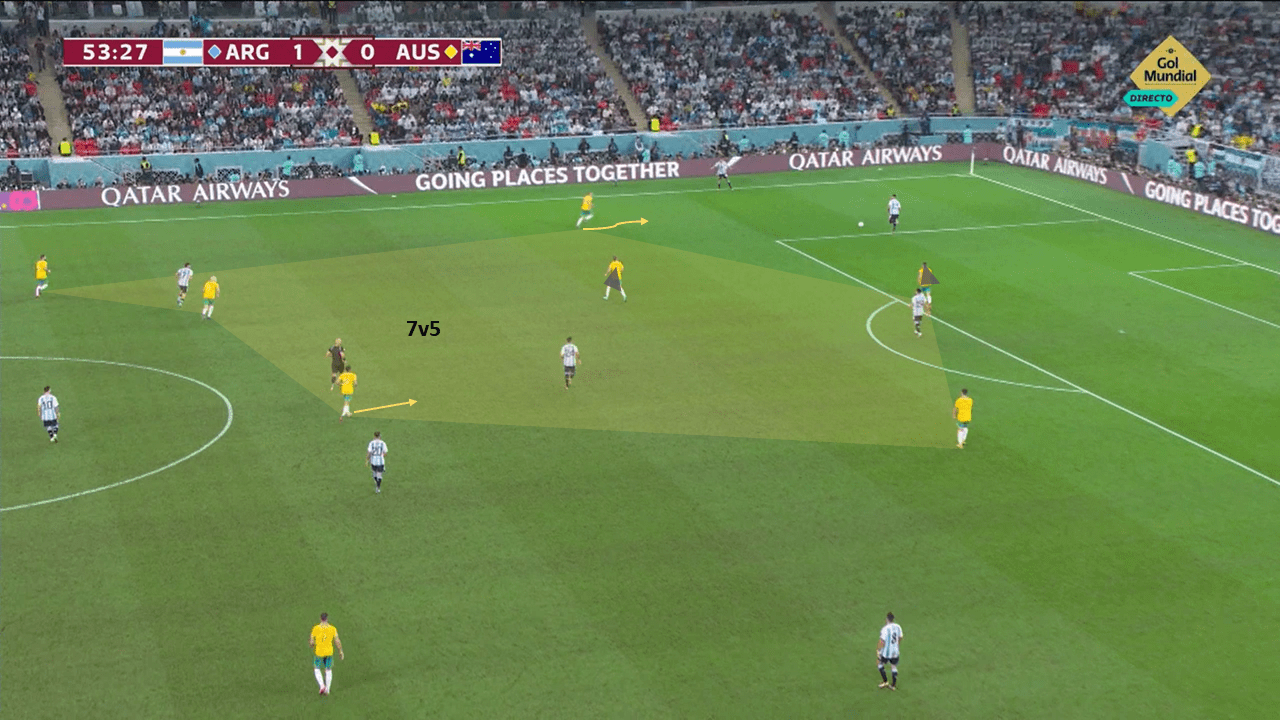
During the game, Australia didn’t exploit the transitions from these balls they got it back from high-pressing schemes and were bad with the ball. Also, Argentina didn’t exploit provoking Australia to let their mid-block move higher and let spaces in behind.
Pressure triggers create chances
Both teams tried to apply high-pressing schemes and used triggers like backward pass, poor body shape, and poor touch to cause a dilemma. Any pressing system has active and passive players you have wealth if you have players like Julián Álvarez and Rodrigo de Paul.
In their second goal, Argentina’s players Julián Álvarez and Rodrigo de Paul were a good example. Immediately they intended to press after the back pass from the center back to Mathew Ryan especially Julián Álvarez read the play very well.
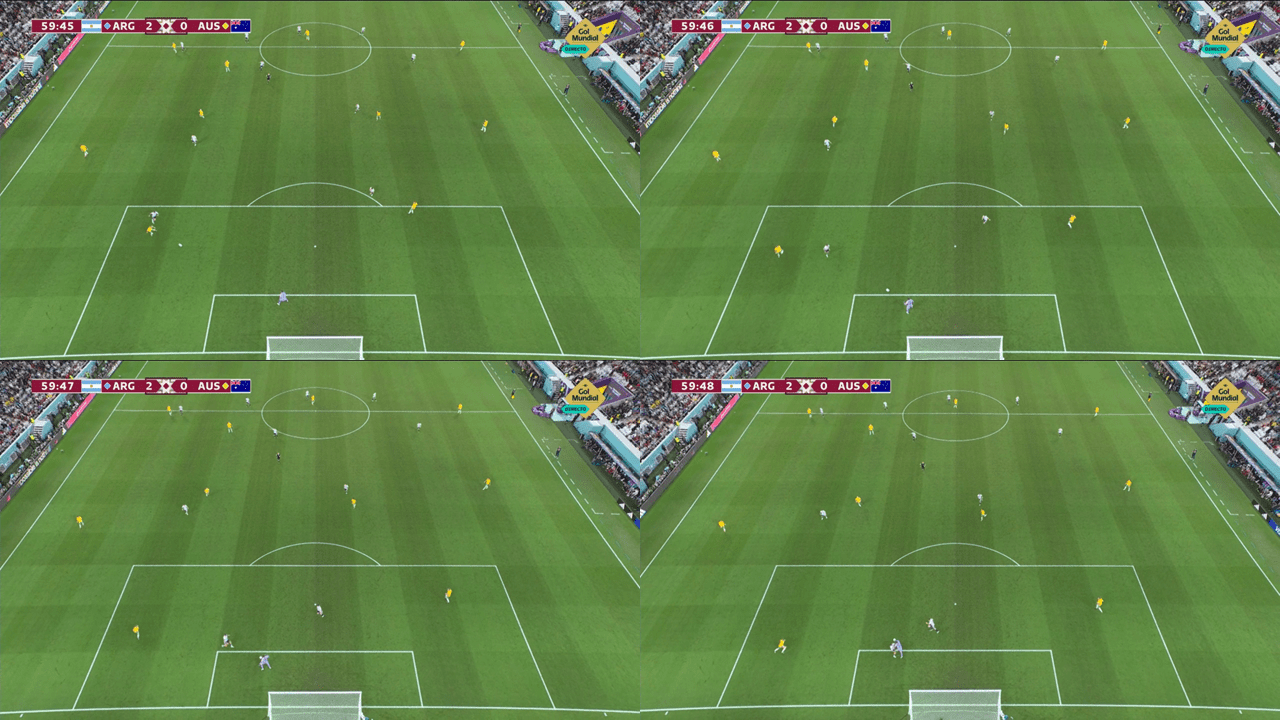
Also, Australia’s strikers were there doing the same. In the scene below, Mitchell Duke was almost to score after a poor back pass from Nicolas Otamendi but Emiliano Martinez quickly put it away.
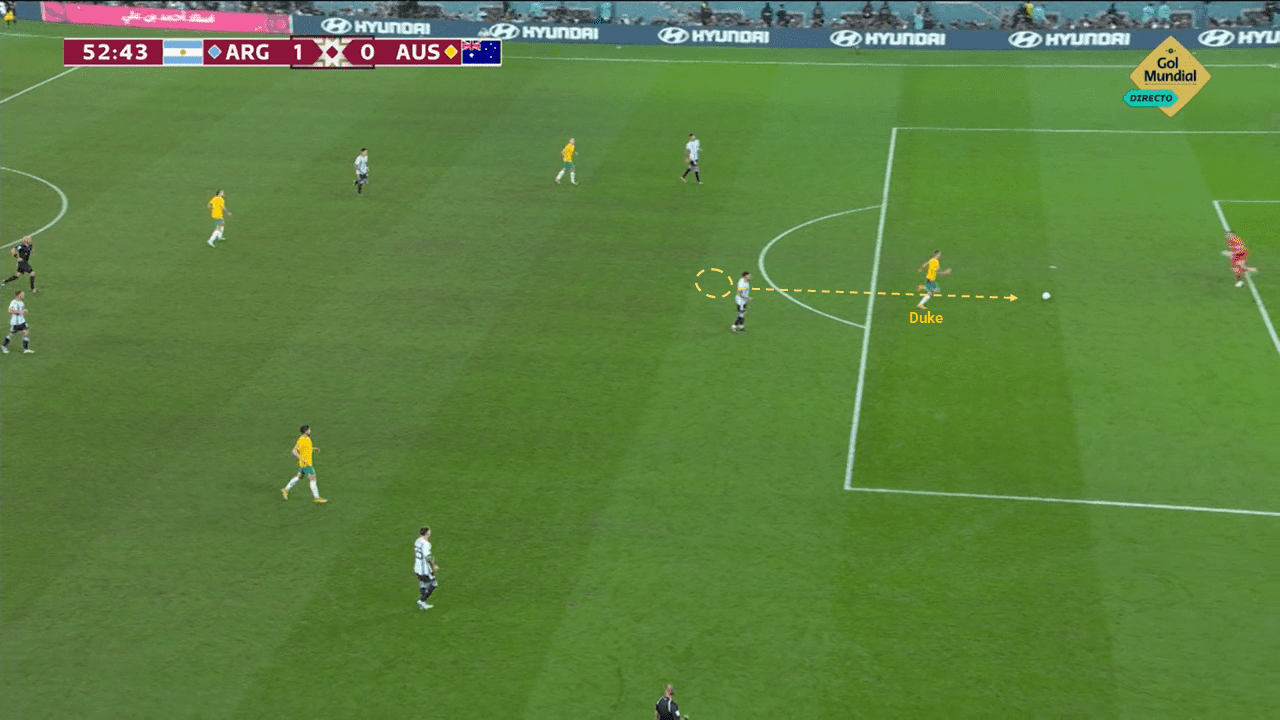
Conclusion
Despite doing a decent defensive game that was not enough for the Aussies to write the history in Qatar. while they had the ball, unless their long balls, they didn’t have a proper idea to score.
Through a 3rd man combination, Lionel Messi scored his 9th goal of the World Cup and became the second-best scorer for Argentina. La Albiceleste to a hard quarter-final against the Netherlands.





Comments